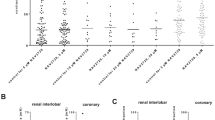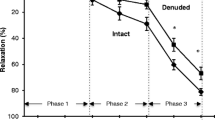Summary
Nitrovasodilators have been found to relax vascular smooth muscle by stimulating soluble guanylate cyclase and thus by increasing the formation of cyclic GMP (cGMP). This nucleotide is responsible for relaxation, most likely by decreasing cytosolic free Ca2− by one or several mechanisms. Repeated administration of organic nitrates causes tolerance development characterized by a diminished relaxing effect and an attenuated rise in cGMP Experiments in isolated circular strips from bovine coronary arteries were performed in order to study the mechanism of tolerance development. It was found that after nitroglycerin (NG) pretreatment the response of the coronary strips to NG was less sensitive with respect to relaxation and increases in cGMP These strips were also cross-tolerant against isosorbide-5-mononitrate, which by itself caused only little tolerance. With NG, the degree of tolerance development depended on the time and the concentration of NG pre-exposure. NG was found to stimulate guanylate cyclase (GC) in coronary supernatant provided that cysteine was added to the incubation medium. As in the intact strips, activation of GC by NG was attenuated when supernatants were preincubated with NG. It was found that addition of cysteine during incubation lessened the degree of desensitization but did not prevent it completely. Similarly, in coronary strips, tolerance development was lower whenN-acetylcysteine was present during pre-exposure of the strips with NG. Considerably more effective in preventing tolerance development by about 50% was L-2-oxothiazolidine-4-carboxylate (OTC), a substance that easily penetrates into the cell and is transformed into cysteine by 5-oxo-prolinase. It is concluded that the high degree of tolerance seen after NG is connected with its particular dependence on cellular cysteine for GC stimulation (or formation of an active intermediate, e. g., NO), since other nitrovasodilators that do not need cysteine addition for GC stimulation (SIN-1, nitroprusside-Na) cause very little or much less tolerance.
Similar content being viewed by others
References
Katsuki S, Arnold W, Mittal C, Murad F (1977) Stimulation of guanylate cyclase by sodium nitroprusside, nitroglycerin and nitric oxide in various tissue preparations and comparison to the effects of sodium azide and hydroxylamine. J Cyclic Nucleotide Res 3: 23–35
Kukovetz WR, Holzmann S, Wurm A, Pöch G (1979) Evidence for cyclic GMP-mediated relaxant effects of nitro-compounds in coronary smooth muscle. Naunyn Schmiedebergs Arch Pharmacol 310: 129–138
Gruetter CA, Barry BK, McNamara DB, Gruetter DY, Kadowitz PJ, Ignarro LJ (1979) Relaxation of bovine coronary artery and activation of guanylate cyclase by nitric oxide, nitroprusside and a carcinogenic nitrosoamine. J Cyclic Nucleotide Res 5: 211–224
Popescu LM, Panoiu C, Hinescu M, Nutu O (1985) The mechanism of cGMP-induced relaxation in vascular smooth muscle. Eur J Pharmacol 107: 393–394
Twort CHC, van Breemen C (1988) Cyclic guanosine monophosphate enhanced sequestration of Ca2+ by sarcoplasmic reticulum in vascular smooth muscle. Circ Res 62:961–964
Rapoport RM (1986) Cyclic guanosine monophosphate inhibition of contraction may be mediated through inhibition of phosphatidylinositol hydrolysis in rat aorta. Circ Res 58: 407–410
Feelisch M, Noack EA (1987) Correlation between nitric oxide formation during degradation of organic nitrates and activation of guanylate cyclase. Eur J Pharmacol 139: 19–30
Needleman P, Johnson EM Jr (1973) Mechanism of tolerance development to organic nitrates. J Pharmacol Exp Ther 184: 709–715
Gruetter CA, Lemke SM (1985) Dissociation of cysteine and glutathione levels from nitroglycerin-induced relaxation. Eur J Pharmacol 111: 85–95
Schmidt K, Kukovetz WR (1986) Stimulation of soluble coronary arterial guanylate cyclase by SIN-1. Eur J Pharmacol 122: 75–79
Palmer RMJ, Ferrige AG, Moncada S (1987) Nitric oxide release accounts for the biological activity of endothelium-derived relaxing factor. Nature 327: 524–526
Furchgott RF, Zawadzki JV (1980) The obligatory role of endothelial cells in the relaxation of arterial smooth muscle by acetylcholine. Nature 288: 373–376
Holzmann S (1982) Endothelium-induced relaxation by acetylcholine associated with larger rises in cyclic GMP in coronary arterial strips. J Cyclic Nucleotide Res 8: 409–419
Holzmann S, Kukovetz WR (1983) Role of cyclic GMP in endothelium-dependent relaxation of coronary strips by acetylcholine. Naunyn Schmiedebergs Arch Pharmacol 322 [Suppl]: R44 (Abstract 174)
Kukovetz WR, Holzmann S (1985) Cyclic GMP in endothelium dependent relaxation of coronary smooth muscle by acetylcholine. Bevan JA, Godfraind T, Maxwell RA, Stoclet JC, Worcel M (eds) Vascular neuroeffector mechanisms. Elsevier, Amsterdam New York Oxford, pp 115–121
Bogaert MG, De Schaepdryver AF (1968) Tolerance towards glyceryl trinitrate (Trinitrin) in dogs. Arch Int Pharmacodyn 171: 221–224
Needleman P (1970) Tolerance to the vascular effects of glyceryl trinitrate. J Pharmacol Exp Ther 171: 98–102
Axelsson KL, Andersson RGG, Wikberg JES (1982) Vascular smooth muscle relaxation by nitro compounds: reduced relaxation and cGMP elevation in tolerant vessels and reversal of tolerance by dithiothreitol. Acta Pharmacol Toxicol (Copenh) 50: 350–357
Kukovetz WR, Holzmann S (1983) Mechanism of nitrate-induced vasodilation and tolerance. Z Kardiol [Suppl 3] 72: 14–19
Kukovetz WR, Holzmann S (1985) Mechanism of vasodilation by molsidomine. Am Heart J 109: 637–640
Romanin C, Kukovetz WR (1988) Guanylate cyclase activation by organic nitrates is not mediated via nitrite. J Mol Cell Cardiol 20: 389–396
Boettcher B, Meister A (1984) Synthesis of L-2-oxothiazolidine4-carboxylic acid. Anal Biochem 138: 449–450
Romanin C, Kukovetz WR (1989) Tolerance to nitroglycerin is caused by reduced guanylate cyclase activation. J Mol Cell Cardiol 21: 41–48
Horowitz JD, Antman EM, Lorell BH, Barry WH, Smith TW (1983) Potentiation of the cardiovascular effects of nitroglycerin by N-acetylcysteine. Circulation 68:1247–1253
Torresi J, Horowitz JD, Dusting GJ (1985) Prevention and reversal of tolerance to nitroglycerin withN-acetylcysteine. J Cardiovasc Pharmacol 7: 777–783
Williamson JM, Meister A (1981) Stimulation of hepatic glutathione formation by administration of L-2-oxothiazolidine-4-carboxylate, a 5-oxo-L-prolinase substrate. Proc Natl Acad Sci USA 78: 936–939
Kukovetz WR, Holzmann S, Romanin C, Mayer B, Kaltenegger H (1987) Nitroglycerin-tolerance: Mechanism and counteraction by OTC, an intracellular cysteine delivery system. Xth International Congress of Pharmacology, Sydney, 23–28 August, 1987 (Abstract O 446)
Kukovetz WR, Holzmann S, Mayer B (1989) Prevention of tolerance to organic nitrates by an intracellular cysteine delivery system (OTC). In: Fujiwara M, Narumiya S, Miwa S (eds) Biosignalling in cardiac and vascular systems. Pergamon Press, Oxford New York, pp 403–409
Kukovetz WR, Holzmann S (1984) Der Wirkungsmechanismus von Molsidomin und Nitraten. Med Prax (Sondernummer) 1: 12–17
Kukovetz WR, Holzmann S (1986) Mode of action of nitrates with regard to vasodilatation and tolerance. Z Kardiol 75 [Suppl 3]: 8–11
Kukovetz WR, Holzmann S (1987) Cyclic GMP in nicorandil-induced vasodilatation and tolerance development. J Cardiovasc Pharmacol 10 [Suppl 8]: S25-S30
Waldman SA, Rapoport RM, Ginsburg R, Murad F (1986) Desensitization to nitroglycerin in vascular smooth muscle from rat and human. Biochem Pharmacol 35: 3525–3531
Schröder H, Leitman DC, Bennett BM, Waldman SA, Murad F (1988) Nitrate tolerance and its reversal in cultured rat lung fibroblasts. Naunyn Schmiedebergs Arch Pharmacol 337 [Suppl]: R74 (Abstract 296)
Ahlner J, Axelsson KL, Ekstram-Ljusegren M et al (1988) Relaxation of bovine mesenteric artery induced by glyceryl trinitrate is attenuated by pertussis toxin. Pharmacol Toxicol 62: 155–158
Author information
Authors and Affiliations
Rights and permissions
About this article
Cite this article
Kukovetz, W.R., Holzmann, S. Mechanisms of nitrate-induced vasodilatation and tolerance. Eur J Clin Pharmacol 38 (Suppl 1), S9–S14 (1990). https://doi.org/10.1007/BF01417559
Issue Date:
DOI: https://doi.org/10.1007/BF01417559




